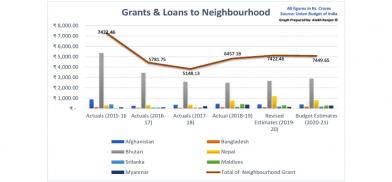India's 'Neighbourhood First' policy: Need to put money where its mouth is
The enthusiasm Modi has shown towards the neighbourhood, through his numerous visits has not got translated in overall policy during these years, writes Alakh Ranjan for South Asia Monitor

The neighbourhood has been central to Indian Prime Minister Narendra Modi’s foreign policy agenda. He has tried since he assumed office to reach out to neighbouring countries. After the announcement of the ‘Neighbourhood First’ policy. Modi has made 13 official visits to neighbouring countries, excluding China. This has resulted in a more robust policy towards the neighbours. Some of these visits by Modi happened after decades. His visit to Nepal in 2014 was the first bilateral state visit of an Indian Prime Minister in 17 years. Similarly, his visit to Sri Lanka was the first bilateral state visit by an Indian Prime Minister after Rajiv Gandhi’s visit in 1987.
However, the enthusiasm Modi has shown towards the neighbourhood, through his numerous visits has not got translated in overall policy during these years. Economic diplomacy is one area which holds critical importance for the neighbouring countries, which look towards India for aid and investments. When the first full budget was presented, in the financial year (FY) 2015-16, the government allocated ₹ 7,290.43 crores to the neighbouring countries, while the total Indian aid to all foreign government in current budget (FY 2020-21) is just ₹ 7,449.65.
Despite the decline in the overall grants and loan budget, the neighbourhood is still the primary focus area, receiving ₹ 5,084.65 crores, or 68% of India’s total aid. This 68% allocation does not show a complete picture. The overall allocation to the region has seen a decline from the last budget.
The countries which have seen a definite decline are Nepal, Maldives and Sri Lanka. Nepal is worst hit, with its economic aid cut by ₹ 400 crores. Bhutan, Bangladesh and Myanmar have received a raise in the current budget. Bhutan still receives the highest share out of all the countries in the budget; with an incremental rise of ₹ 210.14 crores from last year.
The countries which received a hike in the Budget show that India is now focusing more on the Eastern neighbours in its ‘Neighbourhood First’ policy. The reason for this can be attributed to the fact that the government wants rapid development in the North-East Region (NER) states. NER is strategically located and can act as India’s gateway to South-East Asia. It shares a combined border length of 5,438.7 kilometres with Bangladesh, Bhutan and Myanmar. The development of these three countries will have a positive impact on the NER and vice-versa.
The central government understands the importance of NER. Since taking charge the Modi government has not only been increased the allocation of Ministry of Development of North-East Region (DoNER) but also worked towards reducing the gap between the total allocation and total expenditure. In FY 2014-15 only 24% of the total allocation was spent by DoNER, while it was 100% in FY 2019-20. This shows that the government is making sure the funds allocated are spent so that projects are commissioned within the stipulated time.
The commissioning of the project within the stipulated time has been one of India’s major headaches. Countries of the neighbourhood have been consistently complaining about the issue of ‘delivery-deficit’ vis-à-vis Indian projects. The prime example of this is the Kaladan multi-modal project. The project was originally planned to be completed by 2014-15, yet it is still not fully operational. The present government is working towards solving this problem of ‘delivery-deficit’. The Mothihari-Amlekhgunj petroleum pipeline between India and Nepal is an example where the project was completed in half the time (15 months) allocated for it.
The overall budget of grants and loans to the foreign governments in FY 2020-21 show a sharp decline compared to FY 2015-16, but the decline is not very significant compared to FY 2019-20. India’s economy has not been in a good place recently and has, in turn, impacted its loan and aid budget. New Delhi has been cautious with its spending in the neighbourhood as India, with its limited financial resources, should invest in projects which are strategically important to it and positively impact the people of the host country.
(The writer is a Research Assistant, Centre For Land Warfare Studies - CLAWS)








Post a Comment